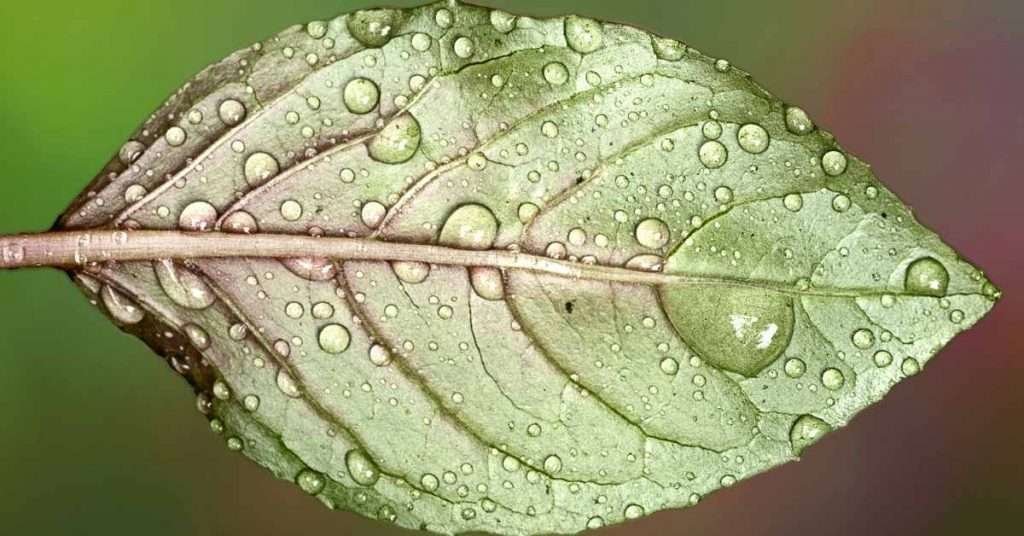- How Do Plants Attract Bees
- Flowers That Attract Bees To Your Garden
- Aster
- Calendula
- Bee Balm
- Blue Borage
- Butterfly Bush
- Chives
- Coreopsis
- Cosmos
- Dahlias
- Grape Hyacinth
- Lavender
- Marigolds
- Marjoram
- Purple Coneflower
- Rudbeckia
- Sunflowers
- Zinnia
- Other Ways to Get Bees to Visit Your Garden
- Provide Drinking Water for Bees
- Adopt Natural Pest Control Measures
- Purchase or Build a Bee box
- Final Thoughts
Do you know you can create a garden buzzing with bees? Yes, you can! And it’s simple. There are a few things you can do to make your garden more bee-friendly by adding a few new plants.
Trying to entice bees into your landscape may seem foolish to some people.
After all, those bees have stingers and can inflict pain on any human that gets too close to them.
But bees are actually more beneficial than harmful and without them, flower, vegetable, nut, and fruit production would be severely curtailed.
These small insects are the number one natural pollinator and by planting certain flowers that attract bees you will be providing them with food so they can do their job and increase their population.
There is a growing awareness of the importance of bees in our ecosystem. However, there are several challenges bees face such as exposure to harmful chemicals, loss of habitat, and climate change. These challenges are causing their numbers to decline. It should be every gardener’s responsibility to play a part to preserve bees. Every gardener should aim to plant flowers in their gardens to help provide the bees with an adequate habitat in our back yards.
Any flower that provides nectar, pollen, and a flat landing surface will be attractive to bees in your areas.
How Do Plants Attract Bees
Insects and bees help plants reproduce. Some plants tend to attract bees to them over others.
Plants with flat or open tubular flowers are attracted to bees because of the pollen and nectar present. Yellow and blue plants tend to most likely attract bees because bees easily perceive those colors. Those with red, on the other hand, are unlikely to attract bees because they are difficult for bees to see. The bright colors and the scent of some plants may also entice bees.
This blog post provides information on the best plants you can have in your garden to lure bees.
However, there are a few specific flowers that seem to attract them more than others, plus these flowers are easy-to-grow and provide landscape color and beauty.
“As an Amazon Associate, I earn from qualifying purchases.”
Flowers That Attract Bees To Your Garden
Aster
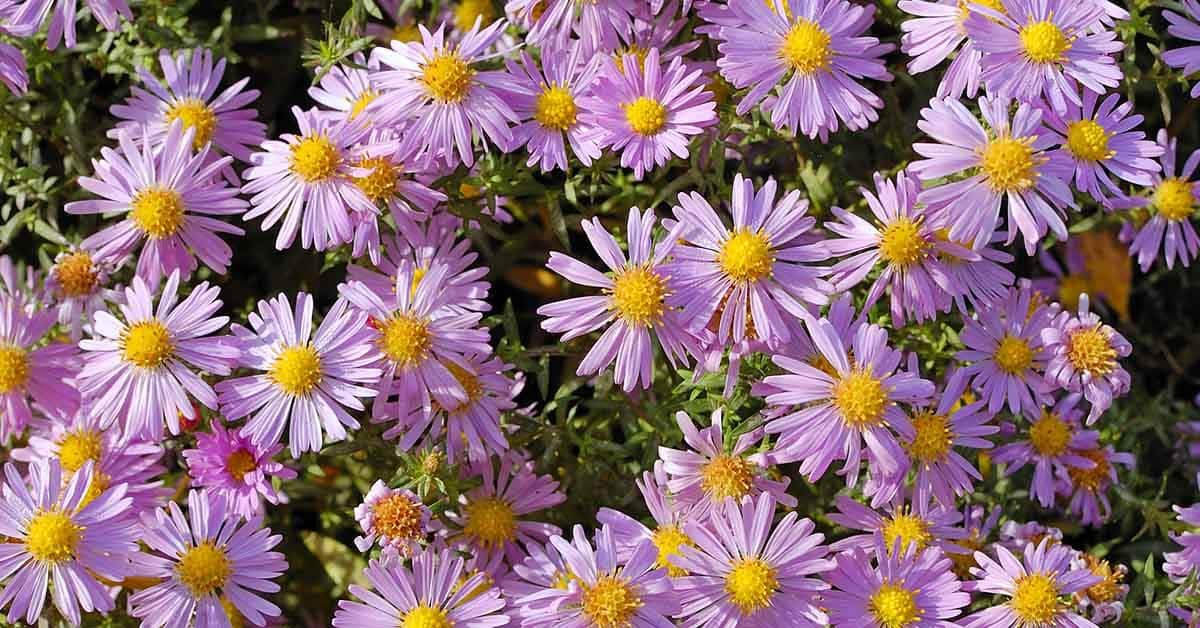
Perennial asters (Aster species) create six-inch tall flower mounds that produce an abundance of white, pink, purple, or blue blooms from late summer until the first frost of fall. Hardy in zones 3 to 8. Sow seeds directly into prepared soil after all danger of frost has passed in the spring.
Calendula

Brilliant orange blooms appear in mid-summer on tall (1-2 feet) annual calendula (Calendula species) plants.
Blooms may be single or double and also come in a variety of colors besides orange, including yellow and cream.
Sow seeds directly into prepared soil after all danger of frost has passed in the spring.
Bee Balm
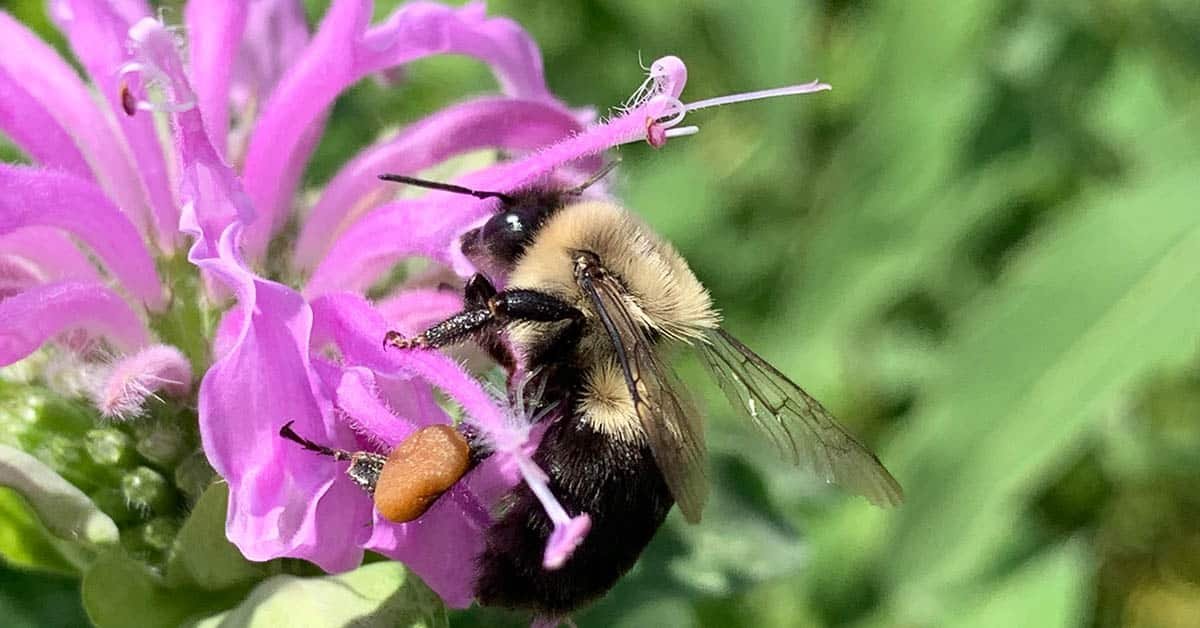
Bee Balm (Monarda species) is a native wildflower that is hardy in zones 3-9.
This tall plant will provide colorful, fragrant flowers all summer when planted in a location that receives plenty of moisture and full sun.
The nectar-rich flowers of Monarda lure bees with purple and pink petals. When it blooms to its peak in mid-summer, it becomes a beehive.
Bee Balm plants are not heat or drought-tolerant, and will not grow well under either extreme condition.
If you live in a region with extreme summer heat, plant the Bee Balm in a garden location that will be shaded from the afternoon sun and give the plants plenty of water throughout the summer.
In addition to attracting bees, this fragrant flower is also a favorite of hummingbirds and can be used for making tea. Start with plants or seeds after the soil warms up in spring.
Blue Borage
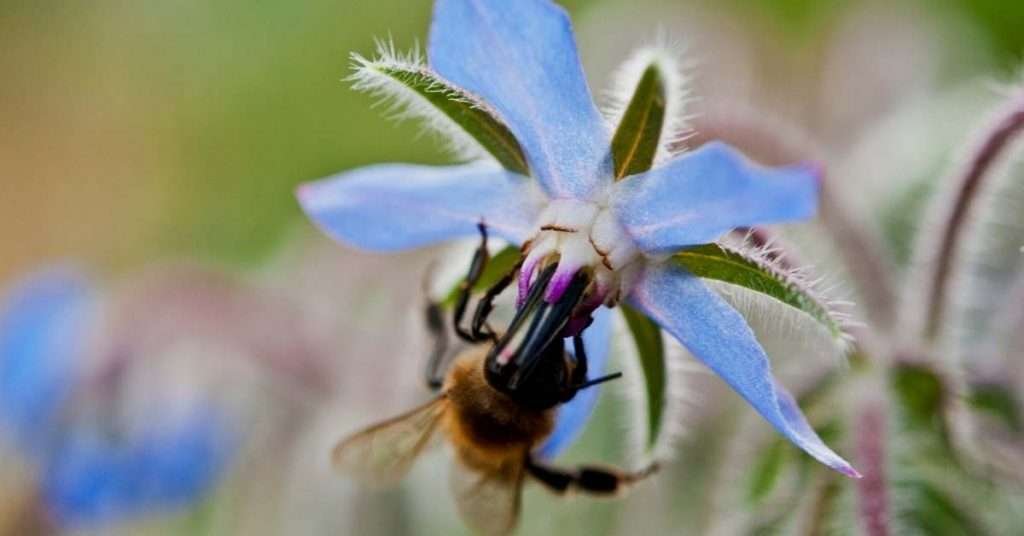
Choosing the blue borage plant to add to your garden is a great idea as it attracts bees with its flowers. Blue Borage has medicinal properties and the leaves and flowers are edible.
Butterfly Bush

The butterfly bush (Buddleia davidii) is an easy-to-maintain plant that adorns your garden. You can also grow this shrub in your garden as a bee-attracting plant. Bees are attracted to its blue, purple, and white flowers. This shrub prefers a sunny location
Chives
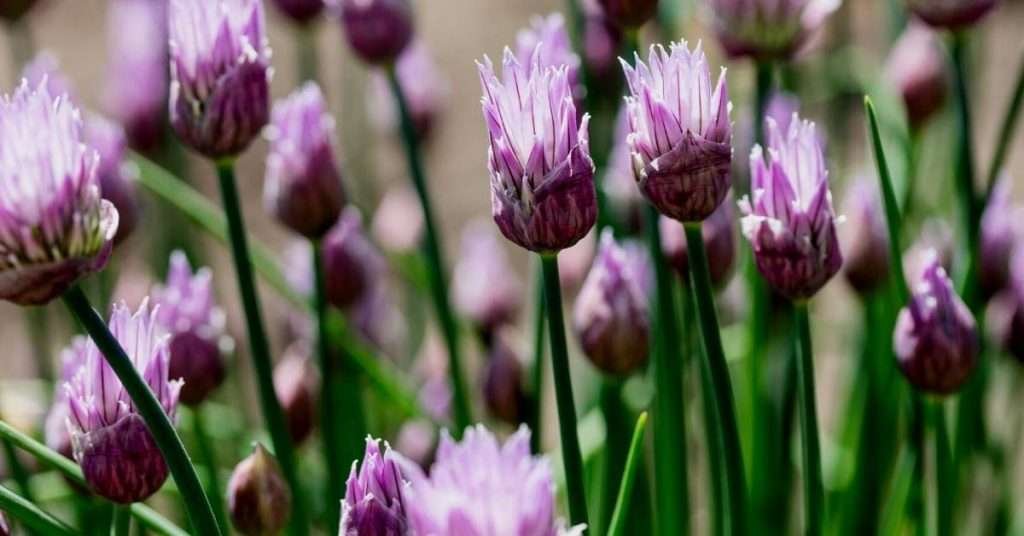
Chives are important to bees because they blossom early in the season, giving the first nectar to the bees! Chives are an excellent choice for gardeners because they are simple to grow and thrive in a variety of climates. Chives can also be used in cooking.
Coreopsis
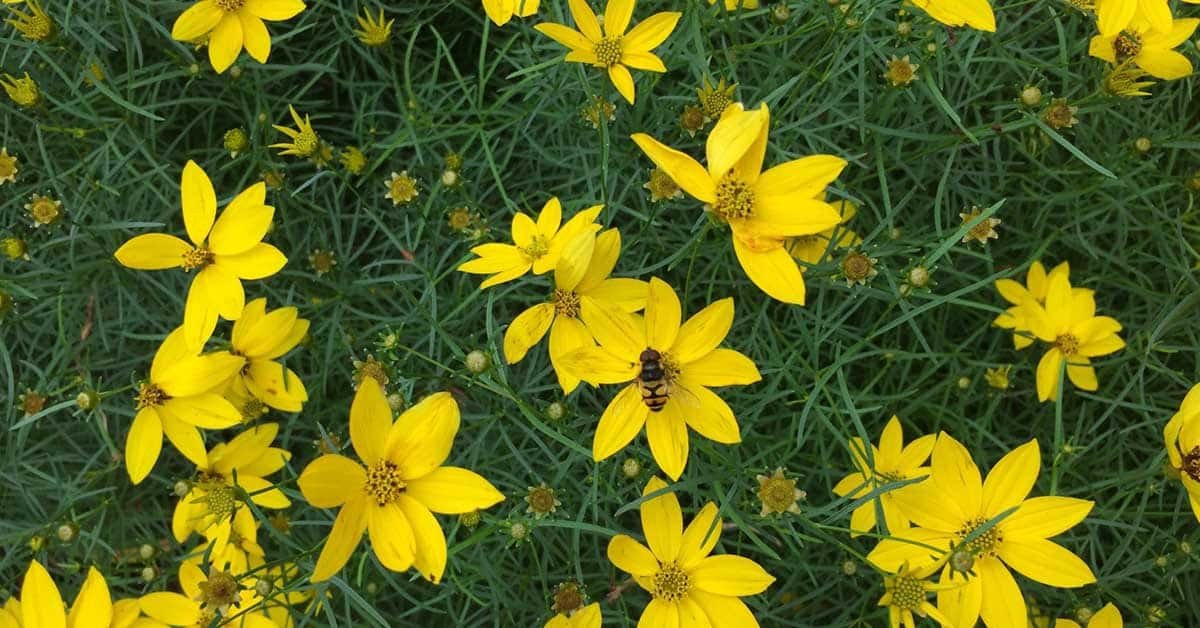
Drought-tolerant, easy-care coreopsis (Coreopsis) will attract bees, butterflies, and birds all summer with its flat bloom that come in colors of red, yellow, pink, orange, or maroon.
This perennial is hardy in zones 3 to 11 and reaches a mature height of between 8 inches and 4 feet depending on the variety planted.
Sow seeds directly into prepared soil after all danger of frost has passed in the spring.
Cosmos

Cosmos (Cosmos bipinnatus) comes in a wide range of bloom colors and plants will reach a mature height of between 1 and 6 feet, depending on the variety planted.
Hardy in growing zones 3-11, this annual flower prefers to be planted in full sun but will grow well almost anywhere.
Sow seeds directly into garden soil after all danger of frost has passed or plant bedding plants after soil has warmed in the spring.
Dahlias

Dahlias (Dahlia) are easy-care flowers that perform their best during the hot, dry days of July, August, and September when most other flowers wilt by the wayside.
Dahlias are hardy in zones 8-10 and come in a wide variety of bloom colors and heights and will attract a steady stream of bees and birds.
Grape Hyacinth

Grape Hyacinth is another plant to consider including in your garden to attract bees. Early in the spring, grape hyacinth blossoms. The blue flowers of the plant attract bees.
Lavender

Bees love lavender because it contains both pollen and nectar. When lavender blossoms in the middle of the summer, it attracts bees. Lavender plants play a crucial role here because bees have fewer options (pickings) at this time of year.
Marigolds

Marigold (Tagetes patula) is one plant you need to consider to attract bees to your garden. Marigold is easy to grow, maintain, is drought-tolerant, requires little care, and will re-seed themselves Their orange and yellow flowers make them attractive to bees.
There are several bloom colors and varieties available and mature heights can range from a few inches to a few feet.
Hardy in most growing zone, bees love all types of marigolds.
Marjoram

Also known as Oregano, this plant has high nectar content. It blooms in the middle of summer when bee colonies are at their largest. For oregano to thrive in your garden, choose a spot that receives sunlight for most of the day.
Purple Coneflower

Bees benefit from purple cone cultivars that bloom in the summer. Because they are easy to grow and manage, these plants are a good addition to your garden. They grow best in full sun and come in a variety of colors, including orange, pink, and yellow.
This tall perennial plant blooms from mid-summer through fall and provides decorative seed heads once the blooming is finished.
Hardy in zones 3 to 9 and attracts a variety of butterflies and birds as well.
Rudbeckia

Rudbeckias (Rudbeckia species) also known as Black-eyed Susan is another great bee-friendly addition to your garden. Because bees are naturally drawn to yellow, this plant’s brown-centered, yellow blossoms attract them like a magnet. All varieties of these annual daisy-like flowers are hardy in zones 3 to 9.
Sow seeds into prepared soil after all danger of frost has passed in spring.
Sunflowers

Sunflowers are a gardener’s favorite. Sunflowers not only brighten your garden, but the nectar in the tubular flowers also attracts pollinators, bees inclusive. The large petals of the sunflower help attract many different kinds of bees to your plants including honey bees and bumblebees.
Zinnia

Zinnias (Zinnia species) are annuals that will produce long-lasting blooms from summer until the first killing frost of fall.
Blooms are large and range in colors from white, red, orange, yellow, purple, and lilac and come in single or double petals varieties.
Plants will range in mature height from 6 inches to 3 feet, depending on the variety planted, and are hardy in most all planting zones.
Other Ways to Get Bees to Visit Your Garden
If you can’t afford plants and seeds, there are other cost-effective ways that are easy to implement to attract bees to your yard or garden.
Provide Drinking Water for Bees
Did you know that bees drink water? They do get thirsty, so water is extremely important for bees when they are working. Fill a small container halfway with drinking water and put it in your garden for bees to drink. Make sure your container isn’t too deep, as bees will find it difficult to drink.
- SAFETY DEVICE: Honey bee water feeder the special bee feede equipment for bees is made of plastic, safe and harmless,water feeder for bees can avoid the death of the bees and prolong their life span.
- TRANSPARENT BEE FEEDER: Easy to observe the bee drinking nest is very easy to observe how much water is remaining and plan accordingly without disturbing your bees.
- BEEHIVE FEEDER EASY TO USE: Water feeder equipment for bee special beehive water feeder tools, easy to operate. After installation in seconds, and put the bee water entrance device in the right place, so that bees naturally find water to provide more convenience.
- BEE FEEDERS WIDE APPLICATION: Beehive entrance feeder for beekeeping bee feeder. This bee entrance feeder could slip water automatically save time and energy for beekeeping farmer.
- PLEASE NOTE: If you want the water to drip quickly, please do not keep the beehive water dispenser too tight on the yellow pad. The water drips speed can be controlled by the adjust the tightness effectively(After receiving the product, hold the product with both hands and gently rotate both ends to separate it)
Adopt Natural Pest Control Measures
Instead of using harmful chemicals to control weeds and pests, why not adopt safer pest control methods? Bees are discouraged when insecticides are used in the garden. Use natural pest control strategies such as planting pest-repelling plants.
Purchase or Build a Bee box
A bee box is an enclosed building that serves as a bee’s home. A bee box in your garden encourages bees to stay. Alternatively, you can construct your beehive using the materials already available in your yard.
- Premium Quality Construction: Hoover Hives' Original Beeswax Coated Beehive Kit is crafted with precision and durability in mind, ensuring years of reliable use in your beekeeping endeavors.
- Complete Kit for Success: This comprehensive kit includes two deep boxes and one medium box, along with wooden frames and heavy wax-coated foundations, providing everything you need to establish a thriving hive.
- Easy Assembly: With predrilled boxes and included screws, setting up your beehive is a breeze, allowing you to focus more on your bees and less on assembly hassles.
- Optimized Hive Design: The two deep boxes offer ample space for brood rearing, while the medium box serves as the perfect honey super, facilitating efficient colony management and honey extraction.
- Sustainable and Reliable: Trust in Hoover Hives' commitment to quality and sustainability, and experience the satisfaction of nurturing healthy colonies and harvesting delicious honey with ease.
Final Thoughts
Certain plant varieties might attract a large number of bees to your yard. Blue, yellow, white, and purple blossoms with one ring of petals are naturally attractive to bees. These are plants or blooms that provide more pollen and nectar and make pollen collection easier for bees. Alternatively, you may build a bee-friendly garden by using a few low-cost bee-attractive measures.
Create a garden with plenty of drinking water for bees and invest in a bee box to give a home for them. Finally, use natural pest control methods and leave detritus in your garden, such as deadwood, to give a home to wild bees.





